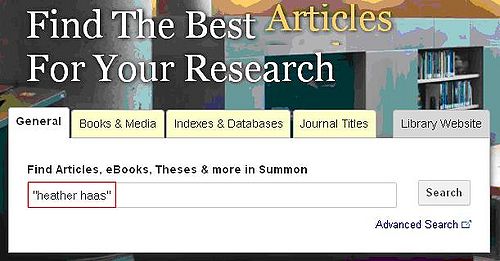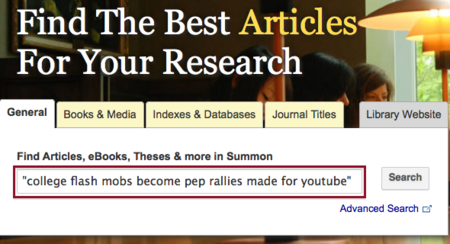Library:Finding Sources from Citations
3.1 Recognizing Different Types of Citations
A bibliographic citation is a reference that points towards a specific source of information. Citations can refer to a wide variety of published or unpublished works, such as books, journal articles, dissertations, and films. A complete citation provides all the pieces of information that you need to track down a source that has been referenced in a paper or been assigned as part of your class readings.
It is important to be able to recognize what citations look like for various types of information sources (e.g. books or journal articles), because you need to use different strategies to locate different kinds of materials. You can identify common types of citations by the information elements that they contain. While some elements are common to most citations (such as the author/creator of the work and the date of publication), other elements provide clues about the kind of information source that is being cited.
Each type of citation can be formatted in different ways, depending on which citation style is being used. The examples below in this guide show both MLA and APA citation styles.
Books
| Citation Elements | Item Details | Sample Citations |
|---|---|---|
| Author(s) | Jordan, Tim
Taylor, Paul A. |
MLA Style:
Jordan, Tim, and Paul A. Taylor. Hacktivism and Cyberwars: Rebels With a Cause? New York: Routledge, 2004. Print. |
| Title | Hacktivism and Cyberwars: Rebels Without a Cause? | |
| Place of Publication | New York | APA Style:
Jordan, T., & Taylor, P. A. (2004). Hacktivism and cyberwars: Rebels with a cause? New York, NY: Routledge. |
| Publisher Name | Routledge | |
| Year of Publication | 2004 | |
| Medium of Publication |
Distinguishing Features
- Only one title appears in the citation
- The citation includes the place of publication and the publisher's name
Look It Up
To find the book use the advanced Books & Media search. Change the drop-down menu to "Title" as with the example below. Remember to omit the initial a/an/the.
Book Chapters
This type of citation includes all of the elements of a regular book citation, along with a few additional pieces of information. Individual chapters are usually cited when they form part of an edited collection, which contains chapters or essays contributed by several different authors.
| Citation Elements | Item Details | Sample Citations |
|---|---|---|
| Author(s) | Eco, Umberto | MLA Style:
Eco, Umberto. “Casablanca: Cult Movies and Intertextual Collage.” Modern Criticism and Theory: A Reader. Ed. David Lodge. New York: Longman, 1988. 446-455. Print. |
| Chapter Title | Casablanca: Cult Movies and Intertextual Collage | |
| Book Title | Modern Criticism and Theory: A Reader | |
| Editor(s) | Lodge, David | |
| Place of Publication | New York | APA Style:
Eco, U. (1988). Casablanca: Cult movies and intertextual collage. In D. Lodge (Ed.), Modern criticism and theory: A reader (pp. 446-455). New York, NY: Longman. |
| Publisher Name | Longman | |
| Year of Publication | 1988 | |
| Page Numbers | 446-455 | |
| Medium of Publication |
Distinguishing Features
- The citation includes two titles: the title of the individual chapter and the title of the book in which it is published
- The place of publication and publisher name indicate that the item is part of a book
- Information about the editor(s) is given (Note that regular book citations can also contain this element, so you need to confirm other features of a book chapter citation)
- The citation contains the page number range for the chapter
Look It Up
To find a book chapter use the advanced Books & Media search. Change the drop down to "Title" as with the example below. Search by the title of the whole book. Remember to omit the initial a/an/the.
Journal Articles
At first glance, journal article citations can look very similar to book chapter citations. In particular, journal article citations also contain two titles: the title of the article and the title of the journal. However, different publication information is given for a journal article.
For example, the table below shows a sample citation in MLA and APA style, and the kind of information it displays:
| Citation Elements | Item Details | Sample Citations |
|---|---|---|
| Author(s) | Haas, Heather A. | MLA Style:
Haas, Heather A. “The Wisdom of Wizards—and Muggles and Squibs: Proverb Use in the World of Harry Potter.” Journal of American Folklore, vol. 124, no. 492, 2011, pp. 29-54. |
| Article Title | The Wisdom of Wizards—and Muggles and Squibs: Proverb Use in the World of Harry Potter | |
| Journal Title | Journal of American Folklore | |
| Volume Number | 124 | APA Style:
Haas, H. A. (2011). The wisdom of wizards—and muggles and squibs: Proverb use in the world of Harry Potter. Journal of American Folklore, 124(492), 29-54. |
| Issue Number | 492 | |
| Year of Publication | 2011 | |
| Page Numbers | 29-54 | |
| Medium of Publication |
Distinguishing Features
- The citation includes two titles: the title of the individual article and the title of the journal in which it is published
- No place of publication or publisher's name is given
- Instead, the citation specifies the exact volume and issue of the journal that is being referenced
Look It Up
To find journal articles by title, you can use Summon. Type the title of the article in the "General" search box on the library homepage. As with the example below, remember to add quotations to search for the title as a phrase.
To find journal articles by author, you can use Summon. Type the name of the author in the "General" search box on the library homepage. As with the example below, remember to add quotations to search for the author as a phrase.
To get the full text of an article. Look for terms like "Link to full text", HTML Full Text, PDF, for example:
IF you don't see a link to PDF or HTML full text, click on the![]() button to connect to full text.
button to connect to full text.
Newspaper Articles
Newspaper article citations closely resemble journal article citations. However, the publication information differs slightly for these two information sources.
| Citation Elements | Item Details | Sample Citations |
|---|---|---|
| Author(s) | Duara, Nigel | MLA Style:
Tamar Lewin. "College Flash Mobs Become Pep Rallies made for YouTube." New York Times 4 October 2011:A.12. Print |
| Article Title | College Flash Mobs Become Pep Rallies made for YouTube | |
| Newspaper Title | New York Times | APA Style:
Tamar Lewin. (2011, October 4). College flash mobs become pep rallies made for YouTube. New York Times, pp. A.12. |
| Date of Publication | 2011 | |
| Page Numbers | A.12 | |
| Medium of Publication |
Distinguishing Features
- The citation includes two titles: the title of the individual article and the title of the newspaper
- No place of publication or publisher's name is given
- No volume or issue numbers are given
- The publication date includes the day, month, and year
Look It Up Via
To find newspaper articles by title, you can use Summon. Type the title of the article in the "General" search box on the library homepage. As with the example below, remember to add quotations to search for the title as a phrase.
For more information on telling different types of citations apart, check out this UBC Library tutorial.
Incomplete Citations
Sometimes, you only have a partial citation (like a title or author's name) for a source that you need to locate. However, there are several techniques that you can use to find the information source, or at least the rest of the citation:
Searching UBC Library's Website
| What You Have | Where to Search | Tips |
|---|---|---|
| Title | Summon | Use quotation marks to search the title, or a distinctive portion of the title, as a phrase (e.g. "Wisdom of Wizards"). |
| Author(s) | Summon's Advanced Search | Use the "Written/created by" field
Single Author: enter the author's first and last name for best results Multiple Authors: enter last names only (start with two and add more to narrow the results) |
| Journal Title
Volume Number Issue Number |
Journal Search | Search the journal's title. After accessing the journal through the Library's databases, locate the list of past volumes and issues, select the correct one, and either browse through it to find the article or locate the appropriate page range (if you have that information). |
Searching Google Scholar
This academic search engine is often successful at retrieving a fuller citation, or the information source itself, with minimal citation information. If you have a title (for a book, book chapter, article, journal, or other source), try phrase searching with quotation marks. Otherwise, enter what citation information you do have, and see what you can find. For more information on searching with Google Scholar, see this UBC Library guide.
If you need any additional information or assistance in reading citations or locating sources, feel free to contact UBC Library.




